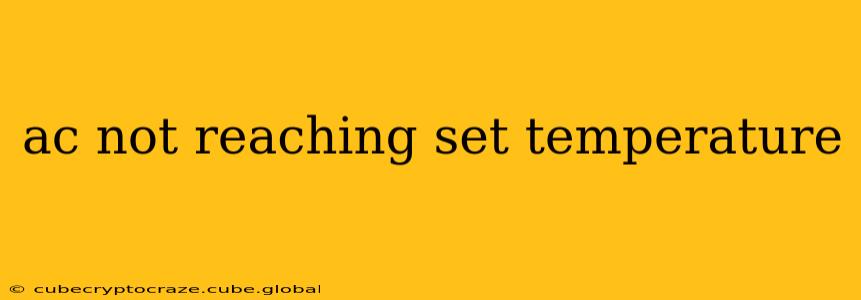Is your air conditioner struggling to reach the desired temperature? A malfunctioning AC unit can be incredibly frustrating, especially during a heatwave. This comprehensive guide will help you diagnose the problem and find solutions, saving you time, money, and potential discomfort. We'll cover common causes and offer practical steps to get your AC blowing cool air again.
Why Isn't My AC Getting Cold Enough?
This is the central question many homeowners face. Several factors can contribute to an air conditioner failing to reach its set temperature. Let's explore the most frequent culprits:
Dirty Air Filter:
This is the most common and easiest problem to fix. A clogged air filter restricts airflow, forcing your AC unit to work harder and potentially preventing it from reaching the set temperature. A dirty filter can also reduce efficiency and shorten the lifespan of your system.
Solution: Regularly check and replace your air filter according to the manufacturer's recommendations (usually every 1-3 months). A clean filter ensures optimal airflow and improves your AC's performance.
Refrigerant Leaks:
Refrigerant is the substance that absorbs heat from your home's air. Leaks in the refrigerant lines can lead to insufficient cooling, as there isn't enough refrigerant to do the job effectively. Low refrigerant levels often require professional attention.
Solution: A qualified HVAC technician needs to identify and repair any refrigerant leaks. Attempting to handle this yourself can be dangerous and void any warranties.
Frozen Evaporator Coil:
A frozen evaporator coil is another common issue. This often stems from restricted airflow (due to a dirty filter or clogged vents) or low refrigerant levels. The ice buildup prevents proper heat absorption, hindering the AC's ability to cool.
Solution: If you suspect a frozen evaporator coil, turn off your AC unit and allow it to thaw completely. Then, check and clean the air filter, ensuring there are no airflow obstructions. If the problem persists, call an HVAC technician.
Compressor Issues:
The compressor is the heart of your AC unit, responsible for circulating the refrigerant. A malfunctioning compressor can prevent the AC from producing sufficient cold air. This is often a more serious problem requiring professional repair or replacement.
Solution: A failing compressor usually requires professional diagnosis and repair by a qualified HVAC technician. This is a significant repair and potentially expensive.
Blocked Vents or Registers:
Obstructions in your air vents or registers can restrict airflow, preventing cool air from circulating throughout your home effectively.
Solution: Check all your vents and registers to ensure they are free from obstructions like furniture, rugs, or curtains. Clean them thoroughly if necessary.
Problems with the Condenser Unit (Outdoor Unit):
The outdoor unit, or condenser, plays a crucial role in the cooling process. Dirt, debris, or overgrown vegetation can restrict airflow and reduce efficiency. Additionally, problems with the condenser fan motor or other components can affect cooling capacity.
Solution: Keep the area around your condenser unit clear of debris and vegetation. If you suspect a problem with the condenser unit itself, call an HVAC technician.
How Often Should I Change My AC Filter?
As mentioned earlier, changing your AC filter is crucial for maintaining optimal performance. The frequency depends on the type of filter and your household environment. However, a good rule of thumb is to replace it every 1-3 months. More frequent changes may be necessary if you have pets, allergies, or live in a dusty environment.
Why is My Air Conditioner Blowing Warm Air?
This often indicates a more serious problem, such as refrigerant leaks, compressor failure, or electrical issues. It's crucial to contact a qualified HVAC technician immediately to diagnose and repair the problem. Continuing to run the unit with warm air can cause further damage.
This guide provides a starting point for troubleshooting your AC unit. If you've tried these steps and your AC is still not reaching the set temperature, it's best to call a qualified HVAC technician for professional assistance. Ignoring the problem could lead to more significant issues and costly repairs down the line. Remember safety first – never attempt repairs beyond your skill level.
